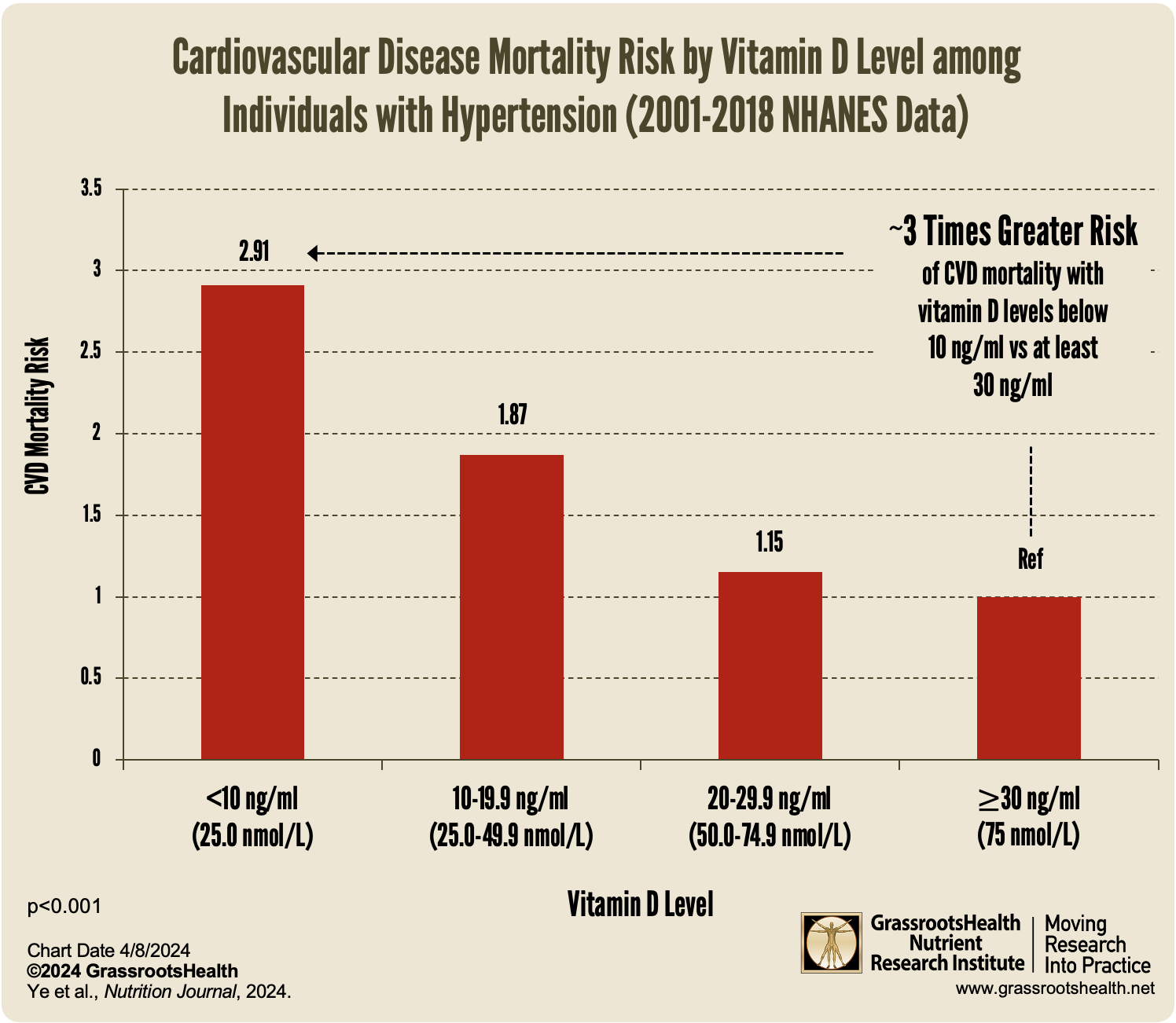Published on April 9, 2024
PLUS 2-Day Flash Sale Ends Today! Two new papers demonstrate the relationship between vitamin D level and mortality risk
Key Points
- A previous study found that death from all causes (including heart disease, and especially cancer) was significantly associated with vitamin D level, with the strongest effect for those starting out with vitamin D deficiency; for these individuals, every 4 ng/ml (10 nmol/L) increase in vitamin D level was associated with a 12% reduction in risk for all-cause mortality and a 9% reduced risk for CVD mortality
- Two new studies based on 2001 to 2018 NHANES data also found that the risk of death decreased significantly as vitamin D levels increased; one study among individuals with hypertension specifically found that for both all-cause mortality and CVD mortality, the risk of death increased as vitamin D levels decreased, with approximately 3 times the risk of death among those with vitamin D levels below 10 ng/ml (25 nmol/L) compared to those with vitamin D levels of 30 ng/ml (75 nmol/L) or higher
- A higher intake of magnesium and a higher Omega-3 Index have also been associated with a lower risk of mortality, highlighting the importance of these additional nutrients as well as vitamin D

Previous studies on vitamin D and mortality have demonstrated a decreased risk of death due to all causes among individuals with higher vitamin D levels. A study by Dai et al. found that death from all causes (including heart disease, and especially cancer) was significantly associated with vitamin D level, with the strongest effect for those starting out with vitamin D deficiency. In fact, for these individuals, every 4 ng/ml (10 nmol/L) increase in vitamin D level was associated with a 12% reduction in risk for all-cause mortality and a 9% reduced risk for CVD mortality.
Two new studies, one by Hu et al. and another by Ye et al., looked at NHANES data from 2001 through 2018 to determine if there was a correlation between vitamin D levels and mortality risk.
Trends in Vitamin D Levels among US Adults (2001 to 2018)
The study by Hu et al. found that, while overall rates of vitamin D deficiency remained at around 22% throughout the survey period, the average vitamin D level increased significantly from 26 ng/ml (65.6 nmol/L) at the beginning of the survey period (2001-2002) to 29 ng/ml (73.5 nmol/L) at the end of the survey period (2017-2018). Vitamin D levels rose among adults who were 60 years or older, as well as females of any age. Levels decreased among those in the 20-39 year old age group. The incidence of vitamin D deficiency remained above 30% among those in the lowest income group, while rates of deficiency decreased among those in the higher income groups.
Risk of Death by Vitamin D Level
In this study, out of 426,438 individuals, there were 6,870 deaths from all-causes, and 2,120 deaths from CVD. The analysis revealed an L-shaped relationship between vitamin D levels and both CVD and all-cause mortality (p<0.001), where the risk of death decreased significantly as vitamin D levels increased.
Another analysis of 2001 to 2018 NHANES data by Ye et al. analyzed data from 19,500 adults with hypertension to assess whether there was a relationship between vitamin D level and mortality. They also found an increased risk of mortality among those with lower vitamin D levels. In fact, for both all-cause mortality and CVD mortality, the risk of death increased as vitamin D levels decreased, with approximately 3 times the risk of death among those with vitamin D levels below 10 ng/ml (25 nmol/L) compared to those with vitamin D levels of 30 ng/ml (75 nmol/L) or higher.
Magnesium and Omega-3 Status Also Related to Mortality Risk
Adequate intake of magnesium from the diet or supplemental sources is necessary for maintaining cardiovascular health and reducing the risk of cardiac events. It is also an important co-factor for vitamin D. Because of the strong association between magnesium and cardiovascular health, Guasch-Ferre et al. conducted a study to determine whether that association also translated to death from cardiovascular disease (CVD), cancer, and all-causes. The authors found that, compared to the participants with the lowest magnesium intake, the participants with the highest magnesium intake had a:
- 47% decreased risk of CVD death (P=0.06)
- 45% decreased risk of death from cancer (P=0.04)
- 37% decreased risk of all-cause mortality (P<0.01)
A higher Omega-3 Index has also been associated with a lower risk of mortality. A study by Harris et al. found that the Omega-3 Index was significantly associated with all but CVD mortality, with total mortality 35% lower in those in the highest Omega-3 Index group (>6.8%) compared to the lowest (<4.2%).
Make Sure You Are Getting Enough Vitamin D, Omega-3s, and Magnesium!
 Having and maintaining healthy vitamin D levels and other nutrient levels can help improve your health now and for your future. Choose which additional nutrients to measure, such as your omega-3s and essential minerals including magnesium and zinc, by creating your custom home test kit today. Take steps to improve the status of each of these measurements to benefit your overall health. With measurement you can then determine how much is needed and steps to achieve your goals. You can also track your own intakes, symptoms and results to see what works best for YOU.
Having and maintaining healthy vitamin D levels and other nutrient levels can help improve your health now and for your future. Choose which additional nutrients to measure, such as your omega-3s and essential minerals including magnesium and zinc, by creating your custom home test kit today. Take steps to improve the status of each of these measurements to benefit your overall health. With measurement you can then determine how much is needed and steps to achieve your goals. You can also track your own intakes, symptoms and results to see what works best for YOU.
Enroll in D*action and Test Your Levels Today!








